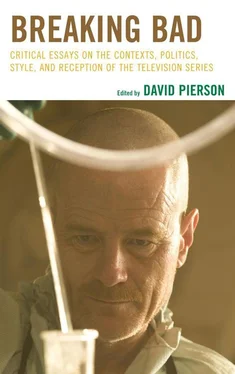The fourth point is tied to the consequences of the uncertainty principle.
The acquisition of knowledge about a system by an observer, even inferential knowledge, can somehow change the behavior of that system or at any rate what the observer subsequently sees in a way unprecedented in classical physics, where the observer plays no special role. (Colin 2004, 39)
Walter White tries to act like an ‘external’ experimenter in the world of drug dealing but his entrance into the field changes the entire domain, making it impossible for him to stand outside. In the first place the distribution of his product will cause a change in the whole balance of the commerce. The blue meth will upset the market of the southern states. In the second place, since the pilot, Walter will not be able to just cook but will get involved in the criminal activities at all levels. An amazing exemplification of the ‘external observer’ illusion can be found in “Caballo Sin Nombre” (3/28/10), where the two Mexican cousins of the cartel wait in Whites’ bedroom for Walter to come out of the shower. One holds an ax in his hand. Walter believes he is an observer, outside of the drug wars being waged between the cartels, but the two cousins (and their ax) act like a revelation. Knowingly or not (he will not see the cousins sitting on his bed), Walt is part of the field. He has produced a consistent change in the international drug business.
The uncertainty principle, the fifth and final point, implies that two mutually exclusive behaviors may happen simultaneously, as displayed in the (in)famous quantum mechanical “Schrödinger’s cat” paradox, where a cat inside a box is alive and dead at the same time (Bruce 2004). In a similar way, we are unable to decide upon Walt’s conduct, simultaneously ‘good’ and ‘bad.’ The most important perspective on the choice of the Heisenberg pseudonym relates probably to this ethical judgment on Walter White’s actions. Can we absolve Walter White from producing drugs and becoming a murderer because he set out with the best intentions and all the bad done was accidental ‘collateral damage?’ Or should we consider him morally guilty? This uncertainty or indeterminacy about Walt’s morality is possibly the most debated topic of the whole series.
Before analyzing this particular feature, we must say that the viewers’ perspective on White’s ethics is subjected to a major development season after season. [8] I have regularly visited http://blogs.amctv.com/breaking-bad , http://www.imdb.com/title/tt093747 and http://www.tv.com/shows/breaking-bad .
We can recognize, from season one to season five, a continuous increase, in blogs and message boards, in the number of commentators that judge Walter morally guilty. “Cornered” (8/21/11) shows in this sense a precise coming out, with Walter declaring, “I’m not in danger. I am the danger.” From then on, it is a descent into the abyss. In season five the screenwriters’ will to insist on Walter White’s wickedness is manifest. In “Buyout” (8/19/12) Walter happily whistles after having told Jesse that he is very afraid and sad for the death of Drew, the young boy shot in the desert because he witnessed the train robbery. But, as I have already stated, season five does not cancel seasons one through four.
In a series where the idea of “badness” is included in the title, the audience divides between those who absolve Walter and those who condemn him. As with Schrödinger’s cat, the observer has to face a superposition of states. The official AMC Breaking Bad blog has published, after episode one of season five, a very interesting poll on this subject. [9] Please see http://blogs.amctv.com/breakign-bad/2012/07/episode-1-story-sync-poll-results.php . Final poll results.
Two of the questions posed by the survey deal with Walt’s morality.
7. Morality Meter: “Good” Skyler playing the heavy with Ted is…
1. Virtuous—4.25 percent
2. Questionable—16.37 percent
3. Ethically Corrupt—12.15 percent
4. Villainous—17.6 percent
5. Heisenberg—49.64 percent
[…]
10. Morality Meter: “We’re done when I say we’re done.” Walt pushing Saul around is…
1. Virtuous—1.89 percent
2. Questionable—2.56 percent
3. Ethically Corrupt—2.29 percent
4. Villainous—14.91 percent
5. Heisenberg—78.35 percent
This use of “Heisenberg” as a synonym of “I can’t decide” in a moral evaluation is really intriguing. The “Heisenberg” answer is in the place usually occupied by “no opinion / don’t know.” The German scientist’s name stands for uncertainty. “Heisenberg” means two opposite situations (moral and immoral) happening simultaneously.
The trouble with judging Walt’s behavior depends upon two impossibilities. Cinematographic identification always leads the viewer to support the main character to some extent. [10] See Christian Metz’s (1982) classic theory, that distinguishes between primary identification (with the camera) and secondary identification (with a character). The sympathy for Walter is also induced by Bryan Cranston’s previous comic roles in the sitcoms Seinfeld (created by Larry David and Jerry Seinfeld, NBC, 1989-1998) and Malcolm in the Middle (created by Linwood Boomer, Fox, 2000-2006).
“We are all Walter White…. [He] came along and gave us all hope…. Walter White remains our hero, and we root for his success, and the defeat of his foils” (Koepsell and Arp 2012, vii). As this citation demonstrates, secondary identification gets us indeed “too close” to the (evil) subject. We are conscious of it, and possibly afraid. The reaction to this concern may manifest in the assumption of an ironic spectatorial agency (i.e., to fully endorse White’s ‘breaking bad’) or in taking distance from identification, attempting a rational analysis of Walter White’s actions. But the second impossibility deals exactly with the vanity of searching for an objective standpoint, for a perspective that permits one to hold together the several variables of this complex field. Walter is fifty-years-old, his wife is pregnant, he has a teenage son with a disability, he is frustrated with a job for which he is certainly over-qualified, he gave up working with a flourishing industry for unknown reasons, and, most of all, he has cancer with few, if any possibilities to recover. Every mean of understanding gets lost in the uncertainty generated by the multiple crossing of these factors.
In “Full Measure” (6/13/10), should Walter murder the innocent Gale Boetticher, if the alternative is probably being killed himself? And before, in “… And the Bag’s in the River” (2/10/08), should Walter murder Krazy-8 or not, knowing that Krazy-8 would probably exterminate his entire family if he lets him go? Walter forgets to write that fundamental adverb, probably , when, pondering this killing, he makes on his notebook a list of pros and cons. But the future Heisenberg should be aware of the central role of probability. Werner Heisenberg writes in fact that a correct experimental procedure is based on probability function, that represents “a mixture of two things, partly a fact and partly our knowledge of a fact” (Heisenberg 2000, 15).
It is presumptuous to judge these cases from an external point of view and impossible to assume his standpoint. How can we enter the mind of a mortally sick person who knows he is dying? Only a specific, individual, relative angle on the surrounding environment is possible. [11] “If we must blame anyone for the curse of relativism that supposedly afflicts modern thought (no one’s story is ‘privileged’, as the sociologists like to say, above anyone else’s; all viewpoints are equally valid), then probably we should blame Heisenberg more than Einstein. Relativity—the scientific theory of space-time, that is—indeed says that different observers will see events in different ways, but it also offers a framework by which these different viewpoints can be reconciled to a consistent and objective account. Relativity doesn’t deny that there are absolute facts; that’s what the uncertainty principle does” (Lindley 2008, 213).
As Giorgio Agamben (2004) writes speaking about the animal realm,
Читать дальше












